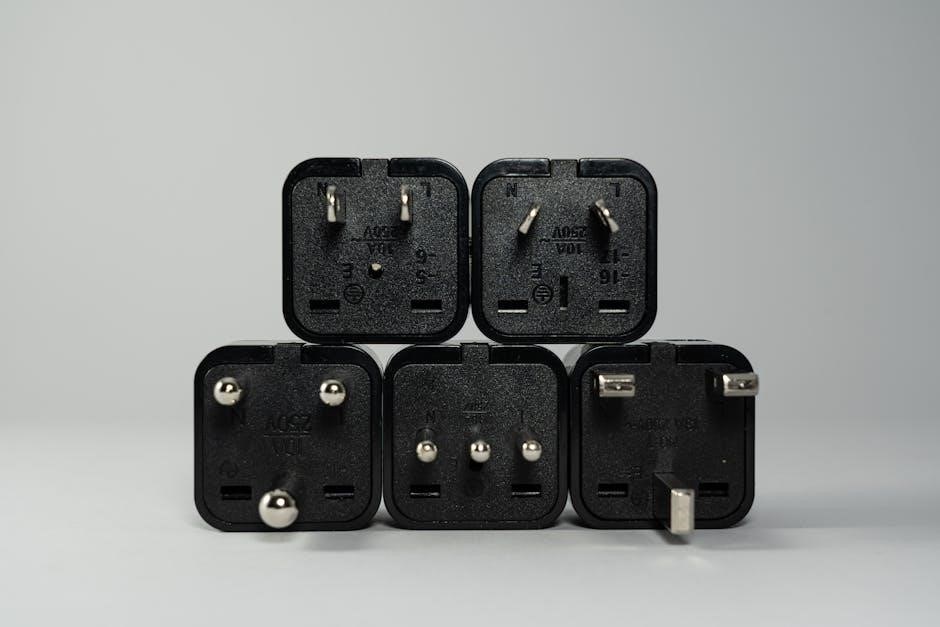
electron configuration worksheet pdf
Electron configuration describes the arrangement of electrons in an atom‚ essential for understanding chemical properties and behavior. It relates to the periodic table‚ bonding‚ and atomic structure‚ forming the basis of chemistry and physics.
1.1 What is Electron Configuration?
Electron configuration refers to the arrangement of electrons in an atom‚ describing how they occupy orbitals in shells and subshells. It follows specific rules‚ such as the Aufbau principle‚ Pauli’s exclusion principle‚ and Hund’s rule‚ to determine the order of electron placement. This arrangement is crucial for understanding an atom’s chemical and physical properties‚ as it influences bonding‚ reactivity‚ and the overall behavior of elements. By mapping the distribution of electrons‚ chemists can predict how atoms will interact and form compounds. Electron configuration is typically represented using notation that indicates the number of electrons in each orbital‚ providing a clear and concise way to visualize the atomic structure. This foundational concept is essential for studying chemistry and serves as the basis for understanding more complex topics like molecular interactions and periodic trends.
1.2 Importance of Electron Configuration in Chemistry
Electron configuration is fundamental to understanding chemical behavior‚ as it explains how atoms interact and form bonds. It determines an element’s valence‚ reactivity‚ and position in the periodic table. By analyzing electron arrangements‚ chemists can predict properties like ionization energy‚ electron affinity‚ and oxidation states. This knowledge is vital for understanding chemical bonding‚ molecular geometry‚ and the formation of compounds. Electron configuration also underpins periodic trends‚ such as why certain elements exhibit similar properties. It aids in predicting the stability of ions and the likelihood of chemical reactions; Furthermore‚ it is essential for advanced topics like molecular orbital theory and crystal field theory. Mastering electron configuration enhances problem-solving skills in chemistry‚ making it a cornerstone of both academic and practical applications in the field.
1.3 Key Concepts and Terminology
Understanding key concepts and terminology is crucial for mastering electron configuration. Terms like orbitals (s‚ p‚ d‚ f) describe where electrons are located‚ while energy levels or shells refer to the layers around the nucleus. The Aufbau Principle explains how electrons fill orbitals in order of increasing energy‚ and the Pauli Exclusion Principle states that no two electrons in an orbital can have the same set of quantum numbers. Hund’s Rule specifies that electrons fill degenerate orbitals singly before pairing. Terms like valence electrons and core electrons differentiate between electrons involved in bonding and those closer to the nucleus. Grasping these concepts and terms is essential for accurately completing an electron configuration worksheet and understanding chemical behavior.

Understanding the Electron Configuration Worksheet
An electron configuration worksheet is a tool used to practice and understand the arrangement of electrons in atoms. It helps visualize orbital filling and energy levels‚ applying key concepts to predict chemical properties and behavior.
2.1 What is an Electron Configuration Worksheet?
An electron configuration worksheet is a structured tool designed to guide users in determining the arrangement of electrons within an atom. It typically includes a series of steps‚ diagrams‚ or tables that outline the process of filling orbitals according to specific rules. These worksheets often provide a framework for understanding the periodic table‚ orbital filling order‚ and the application of principles like the Aufbau principle and Hund’s rule. They are commonly used in educational settings to help students practice and master electron configuration‚ which is fundamental to understanding chemical bonding and periodic trends. The worksheet may include blank orbital diagrams‚ atomic numbers to configure‚ or periodic table references‚ making it an interactive and practical learning aid for visualizing and applying electron configuration concepts effectively.
2.2 Benefits of Using a Worksheet for Electron Configuration
Using an electron configuration worksheet offers numerous benefits‚ particularly for students and learners. It provides a structured approach to understanding and applying electron configuration principles‚ making complex concepts more manageable. Worksheets allow for hands-on practice‚ reinforcing theoretical knowledge through practical exercises. They also help develop problem-solving skills by guiding users through step-by-step processes. Additionally‚ worksheets enable visual learning‚ as they often include diagrams and charts to illustrate orbital filling and electron arrangement. This visual aid enhances comprehension and retention of key concepts. Furthermore‚ worksheets are an effective study tool for preparing for exams or quizzes‚ as they allow learners to test their understanding and identify areas for improvement. Overall‚ electron configuration worksheets are invaluable for building a strong foundation in chemistry and atomic structure.
2.3 Structure of a Typical Electron Configuration Worksheet

A typical electron configuration worksheet is designed to guide learners through the process of determining electron arrangements. It usually begins with a brief introduction or reminder of key concepts‚ such as orbital types (s‚ p‚ d‚ f) and filling order. The worksheet then presents a series of questions or problems‚ often organized by atomic number‚ requiring users to write the electron configuration for specific elements. Many worksheets include step-by-step instructions or examples to help users understand the process. Additionally‚ they may feature charts or diagrams‚ such as the periodic table or orbital filling diagrams‚ to aid visualization. Some worksheets also include blank spaces for drawing orbitals or electrons‚ allowing for hands-on practice. Finally‚ answers or solutions are often provided at the end for reference and self-assessment.

How to Use the Electron Configuration Worksheet
Start by identifying the element’s atomic number‚ then fill orbitals in order‚ following the aufbau principle. Review your work to ensure accuracy and adherence to rules like Hund’s and Pauli’s.
3.1 Step-by-Step Guide to Filling Out the Worksheet
To fill out the electron configuration worksheet‚ start by identifying the atomic number of the element‚ which determines the number of electrons. Next‚ list the subshells in order of increasing energy levels‚ following the aufbau principle. Fill each orbital with the maximum number of electrons it can hold‚ adhering to Hund’s rule for electron pairing. Use arrows to indicate electron spin and ensure you follow the Pauli exclusion principle. For transition metals and noble gases‚ remember their unique electron configurations. Finally‚ review your work to catch any errors‚ ensuring all electrons are accounted for and properly placed.
3.2 Tips for Accurate Electron Configuration
To ensure accurate electron configuration‚ start by thoroughly understanding the periodic table and atomic structure. Always follow the aufbau principle‚ filling orbitals in order of increasing energy. Use Hund’s rule to maximize spin before pairing electrons. Pay special attention to transition metals and noble gases‚ as their configurations often deviate from the norm. Double-check your work to avoid common mistakes like miscounting electrons or skipping energy levels. Use a color-coded system to differentiate orbitals and electron spins for clarity. Practice regularly to build familiarity with patterns and exceptions. Refer to diagrams or charts to visualize orbital filling‚ and verify your configurations against a reliable periodic table. By following these tips‚ you can master electron configuration and improve your chemistry problem-solving skills.
3.3 Common Mistakes to Avoid
When working on an electron configuration worksheet‚ several common mistakes can lead to errors. One of the most frequent is miscounting the total number of electrons‚ especially for transition metals and noble gases. Students often forget to follow the aufbau principle‚ incorrectly filling lower-energy orbitals before higher ones. Another mistake is neglecting Hund’s rule‚ which requires maximizing spin before pairing electrons. Many also overlook exceptions in electron configuration‚ such as chromium and copper‚ which do not follow the usual filling order. Additionally‚ some may confuse orbital capacity or mislabel subshells. To avoid these errors‚ always double-check your work‚ use a periodic table for reference‚ and pay close attention to special cases. Awareness of these common pitfalls will help you complete the worksheet accurately and improve your understanding of electron configuration.

Electron Configuration and the Periodic Table
Electron configuration and the periodic table are deeply connected. The table organizes elements by atomic number‚ reflecting orbital filling patterns. Each period represents a new principal energy level‚ while groups align with valence electrons‚ determining chemical properties and behavior.
4.1 The Relationship Between Electron Configuration and the Periodic Table
The electron configuration of an element is closely tied to its position on the periodic table. The periodic table organizes elements by atomic number‚ which corresponds to the number of protons and electrons in an atom. As you move across a period‚ electrons fill orbitals in a specific order‚ following the Aufbau principle. The periodic table’s structure reflects this filling pattern‚ with each period representing a new principal energy level and each group aligning with the number of valence electrons. This relationship allows chemists to predict an element’s electron configuration based on its position‚ as well as its chemical properties‚ such as reactivity and bonding behavior. Understanding this connection is crucial for leveraging the periodic table to predict trends and patterns in the periodic table.
4.2 How to Determine Electron Configuration Using Periodic Trends
Determining electron configuration using periodic trends involves leveraging the periodic table’s structure. Elements are arranged by atomic number‚ and their positions reveal patterns in electron filling. Moving across a period‚ electrons fill orbitals in a specific order‚ while moving down a group adds electrons to higher energy levels. Periodic trends‚ such as atomic radius and electronegativity‚ also correlate with electron configuration. For example‚ elements in the same group share similar valence electron configurations‚ influencing their chemical behavior. Additionally‚ the periodic table highlights exceptions‚ such as the filling of 4s orbitals before 3d‚ and the stability of half-filled and fully-filled orbitals. By understanding these trends‚ you can predict an element’s electron configuration and its properties‚ making the periodic table a powerful tool for chemists and students alike.
4.3 Exceptions to the Normal Electron Configuration
While electron configuration generally follows the Aufbau principle‚ there are notable exceptions. Chromium (Cr) and Copper (Cu) are prime examples‚ where electrons occupy higher energy orbitals for stability. Chromium has an electron configuration of [Ar] 3d⁵ 4s¹ instead of the expected [Ar] 3d⁴ 4s²‚ while Copper adopts [Ar] 3d¹⁰ 4s¹ instead of [Ar] 3d⁹ 4s². These exceptions occur due to the stability of half-filled and completely filled d orbitals‚ which lower the overall energy of the atom. Similar exceptions are observed in other transition metals and heavier elements‚ where orbital filling prioritizes stability over the traditional filling order. Understanding these exceptions is crucial for accurately predicting electron configurations and explaining chemical properties. These irregularities highlight the complexity of electron interactions and the importance of memorization in mastering electron configurations.

Advanced Topics in Electron Configuration
This section delves into complex concepts such as orbital filling‚ Hund’s Rule‚ and the electron configuration of transition metals and noble gases‚ essential for understanding chemical bonding and periodic trends.
5.1 Orbital Filling and the Aufbau Principle
The Aufbau Principle guides the order in which electrons fill atomic orbitals‚ starting with lower energy levels and following specific rules. Electrons occupy orbitals in a sequence that minimizes energy‚ adhering to the Pauli Exclusion Principle and Hund’s Rule. This principle is fundamental for predicting electron configurations‚ as it dictates how electrons distribute across s‚ p‚ d‚ and f orbitals. Understanding orbital filling is crucial for chemists‚ as it explains periodic trends‚ such as atomic radius and electronegativity variations. Mastery of this concept aids in predicting ion formation‚ chemical bonding‚ and molecular stability. Practice with an electron configuration worksheet pdf helps reinforce these principles‚ ensuring accuracy in determining ground-state configurations and exceptions. This foundation is essential for advanced topics like transition metals and noble gases‚ where electron arrangements deviate from standard patterns.
5.2 Hund’s Rule and Pauli’s Exclusion Principle

Hund’s Rule and the Pauli Exclusion Principle are foundational concepts in electron configuration. Hund’s Rule states that electrons will occupy degenerate orbitals singly before pairing‚ maximizing spin and minimizing repulsion. This rule explains why electrons fill empty orbitals of the same energy level before pairing up. The Pauli Exclusion Principle‚ on the other hand‚ dictates that no two electrons in an atom can share the same set of quantum numbers‚ ensuring electrons occupy unique states. Together‚ these principles govern how electrons distribute in orbitals‚ influencing atomic stability and chemical properties. Understanding these rules is critical for accurately filling out an electron configuration worksheet pdf‚ as they prevent errors in orbital population and pairing. These principles also explain periodic trends‚ such as why certain elements exhibit specific valencies or magnetic properties. Mastery of these concepts enhances the ability to predict and interpret electron configurations across the periodic table.
5.3 Electron Configuration of Transition Metals and Noble Gases
Transition metals and noble gases exhibit unique electron configurations due to their distinct chemical properties. Transition metals‚ found in the d-block of the periodic table‚ often have partially filled d orbitals‚ which contribute to their catalytic and magnetic properties. Their electron configurations frequently follow the Aufbau principle but may include exceptions due to stability factors‚ such as completely filled or half-filled d orbitals. Noble gases‚ located in the p-block‚ have completely filled valence shells‚ resulting in their chemical inertness and stable nature. Understanding these configurations is essential for completing an electron configuration worksheet pdf accurately‚ as it highlights the differences between main-group elements and transition metals. Recognizing these patterns also aids in predicting chemical behavior and exceptions in electron arrangements‚ making it a critical skill for chemistry students and professionals alike.

Solving Problems with the Worksheet

Electron configuration worksheets simplify problem-solving by providing structured templates to practice writing configurations‚ identify patterns‚ and apply principles like Hund’s Rule and the Aufbau Principle for accurate results.
6.1 Practice Problems and Solutions

Practice problems are essential for mastering electron configuration. Worksheets often include exercises like writing configurations for atoms and ions‚ identifying orbital filling patterns‚ and applying exceptions. Solutions are provided for self-assessment‚ helping students understand common mistakes and improve accuracy. Examples range from main-group elements to transition metals and noble gases‚ ensuring comprehensive practice. These problems reinforce concepts like Hund’s Rule‚ the Aufbau Principle‚ and periodic trends‚ while solutions offer clear explanations. Regular practice with diverse problems builds confidence and proficiency in electron configuration‚ a foundational skill in chemistry. By working through these exercises‚ students gain a deeper understanding of how electron arrangements influence chemical properties and bonding.
6.2 Applying Electron Configuration to Chemical Bonding
Understanding electron configuration is crucial for predicting how atoms form chemical bonds. By analyzing the outermost electrons‚ one can determine an element’s valency and bonding tendencies. The periodic table’s recurring patterns in electron configurations explain periodic trends in bonding behaviors. For example‚ elements with nearly full or empty valence shells tend to form ionic or covalent bonds to achieve stable configurations. Transition metals‚ with their partially filled d-orbitals‚ often exhibit variable valency‚ influencing their bonding behavior. Practice problems on worksheets help students connect electron configuration to bonding‚ enabling them to predict molecular structures and reactions. This knowledge is vital in fields like materials science and organic chemistry‚ where understanding bonding is essential for designing compounds and reactions.
6.3 Using the Worksheet for Exam Preparation
Electron configuration worksheets are invaluable tools for exam preparation‚ helping students master the fundamentals of atomic structure and bonding. Regular practice with these worksheets ensures familiarity with key concepts like orbital filling‚ periodic trends‚ and exceptions. By solving a variety of problems‚ students improve their ability to write accurate configurations and understand their relevance to chemical behavior. Worksheets also enhance problem-solving speed and accuracy‚ essential for timed exams. Additionally‚ they help identify common mistakes‚ such as misapplying Hund’s Rule or the Aufbau Principle‚ allowing students to address weaknesses. Consistent practice with worksheets builds confidence and reinforces the connection between electron configuration and broader chemistry topics‚ making them an indispensable resource for successful exam preparation.
7.1 Summary of Key Points
7.2 Final Tips for Mastering Electron Configuration
To master electron configuration‚ practice regularly using worksheets to build familiarity with orbital filling patterns. Understand and apply key principles like the Aufbau‚ Hund’s‚ and Pauli Exclusion rules consistently. Use the periodic table to guide your predictions‚ as elements in the same group or period share similar configurations. Pay special attention to exceptions‚ especially in transition metals and noble gases. Double-check your work to avoid common mistakes‚ such as miscounting electrons or misplacing them in orbitals. Visualizing electron configurations can help reinforce memory‚ and applying concepts to real-world examples enhances understanding. Lastly‚ use group study or tutoring if needed‚ and stay organized by keeping completed worksheets for future reference. With dedication and these strategies‚ you’ll confidently master electron configuration and its applications in chemistry.
Related Posts

pdf to ofx converter online free
Easily convert PDF files to OFX format online for free. No registration required, fast and secure conversion.

tu zona crypto book pdf
Dive into the world of cryptocurrency with our expert guide. Discover tips, tricks, and strategies for success in crypto trading and investing.

cronicas de una muerte anunciada pdf
Get the full “Cronicas de una Muerte Anunciada” book in PDF format instantly. Free download available now at mojopet.com.